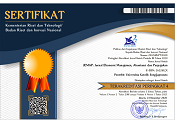Kapabilitas Pemasaran Absorptif, Adaptif, dan Inovatif terhadap Kinerja Pemasaran pada Online Shop Pakaian Wanita di Instagram
Abstract
This study aims to analyze the effect of absorptive marketing capabilities, adaptive marketing capabilities, and innovative marketing capabilities to marketing performance simultaneously and partially on women's clothing online shops on Instagram. Respondents in this study were the owners of women's clothing online shop on Instagram, amounting to 96 respondents. This research was conducted quantitatively by testing the hypothesis using multiple regression that showed the results of the capabilities of absorptive, adaptive, and innovative marketing simultaneously had significant effect on marketing performance; but partially only innovative marketing capabilities had significant effect on marketing performance.
Keywords
Full Text:
PDFReferences
Al-zyadaat, M. A., Saudi, M. A., & Al-awamreh, M. A. 2012. The Relationship Between Innovation and Marketing Performance in Business Organizations : An Empirical Study on Industrial Organizations in the Industrial City of King Abdullah II. International Business and Management, 5(2), 76–84.
Ananda, L. D. 2017. Dinamika Trust pada Pemasaran Online di Media Sosial. Jurnal Komunikasi Indonesia, V(1), 14–25.
Aryanto, A. 2018. 5 Negara dengan Pertumbuhan E-commerce Tertinggi. Warta Ekonomi.
Bakti. 2011. Pengaruh Orientasi Pasar dan Nilai Pelanggan terhadap Kinerja Pemasaran Maskapai Penerbangan Lion Air. Jurnal Manajemen Pemasaran Modern, 3(1), 1–15.
Biedenbach, T., & Müller, R. 2012. Absorptive , innovative and adaptive capabilities and their impact on project and project portfolio performance. JPMA, 30(5), 621–635.
Castillo, D. J., & Perez, M. S. 2013. Market knowledge absorptive capacity: a measurement scale. Information Research, 18(4)
Day, G. S. 2011. Closing the Marketing Capabilities. Journal of Marketing, 75(July), 183–195
Dibrell, C. 2014. Linking the formal strategic planning process, planning flexibility, and innovativeness to firm performance. Journal of Business Research, 67(9), 2000–2007.
Ferdinand, A. 2000. Manajemen Pemasaran: Sebuah Pendekatan Strategy. Research Paper Series, 1.
Gunday, G., Ulusoy, G., Kilic, K., & Alpkan, L. 2009. Effects of Innovation Types on Firm Performance. Intern. Journal of Production Economics, 133(2), 662–676.
Guo, H., Xu, H., Tang, C., Liu-Thompkins, Y., & Guo, Z. 2018. Comparing the impact of different marketing capabilities: Empirical evidence from B2B firms in China. Journal of Business Research, 1–11.
Hendar, H., Ferdinand, A. T., & Nurhayati, T. 2010. Introducing the religio-centric positional advantage to Indonesian small businesses. Management & Marketing. Challenges for the Knowledge Society, 12(1), 78–102.
Hooley, G., Piercy, N. F., & Nicoulaud, B. 2008. Marketing Strategy and Competitive Positioning.
Julianto, P. A. 2018. Pasarkan Produk, UKM Indonesia memilih menggunakan Media Sosial. Retrieved February 11, 2019,
Lane, P. J., Salk, J. E., & Lyles, M. A. 2001. Absorptive Capacity, Learning, and Performance in International Join Ventures. Strategic Management Journal, 22(March), 1139–1161.
Lemeshow, S., Hosmer, D. W., Klar, J., & Lwanga, S. 1997. Adequacy of Sample Size in Studies.
Lichtenthaler, U. 2009. Absorptive Capacity, Environmental Turbulence, and the Complementarity of Organizational Learning Processes. The Academy of Management Journal, 52(4), 822–846.
Moreira, J., Silva, M. J., Simoes, J., & Sousa, G. 2012. Drivers of marketing innovation in Portuguese firms. Economic Interferences, 14(31), 195–206.
Ngamsutti, S., & Ussahawanitchakit, P. 2016. Marketing innovation capability and marketing performance: an empirical study of electrical and electronic appliances in Thailand. The Business and Management Review, 7(5), 339–346.
Oktemgil, M., & Greenley, G. 1997. Consequences of high and low adaptive capability in UK. European Journal of Marketing, 31(7), 445–466.
Poernomo, D., Wahono, P., & Puspitaningtyas, Z. 2018. Daya Serap Pengetahuan dan Akselerasinya pada Kinerja Usaha. Journal of Business and Entrepreneur, 2(1), 15–30.
Purnomo, H., & Santosa, E. 2015. Kapabilitas Pemasaran Dinamis dan Pengaruhnya pada Kinerja pada Industri Kreatif Pascabencana. Jurnal JRMB, 10(2), 158–173.
Riduwan. 2014. Metode dan Teknik Menyusun Tesis. Bandung: Alfabeta.
Saelee, R., & Ussahawanitchakit, P. 2014. Dynamic Marketing Capability and Marketing Performance: An Empirical Investigation of Travel Agency in Thailand. IJBS, 14(2), 61–74.
Santoso, S. 2000. Buku Latihan SPSS Statistik Parametrik. Jakarta: Gramedia.
Saroh, M. 2018. Barang-barang yang Populer di Online Shop. Tirto.id
Sugiyono. 2014. Metode Penelitian Manajemen. Bandung: Alfabeta.
Sukdej, S., & Ussahawanitchakit, P. (2015). Dynamic marketing capability and marketing survival : evidence from auto parts businesses in Thailand. The Business and Management Review, 7(1), 9–10.
Sulistyo, J. 2010. 6 Hari Jago SPSS 17. Yogyakarta: Cakrawala.
Swa. 2018. Jumlah Akun Komunitas Bisnis Instagram di RI Tembus 25 Juta. Majalah Swa
Teece, D. J., Pisano, G. P., & Shuen. 1997. A Dynamic Capabilities and Strategic Management. Strategic Management Journal, 18(7), 509–533.
Thomas, J. 2017. High-Growth B2B Companies Do 4 Things to Manage Marketing Performance. Marketing Insider Group.
Wahyuni, N. D. 2017. 5 Cara agar Bisnis Online Anda Tak Gulung Tikar. Liputan 6
Wang, C. L., & Ahmed, P. K. 2007. Dynamic Capabilities : A Review and Research Agenda. The International Journal of Management Reviews, 9(1), 31–51. R
Welsch, H., Liao, J., & Stoica, M. 2003. Absorptive Capacity and Firm Responsiveness: An Empirical Investifation of Growth-Oriented Firms. Entrepreneurship Theory and Practice, 28(1), 1–19.
DOI: https://doi.org/10.24167/jemap.v3i1.2470
Refbacks
- There are currently no refbacks.
e-ISSN 2622-612X | View My Stats







